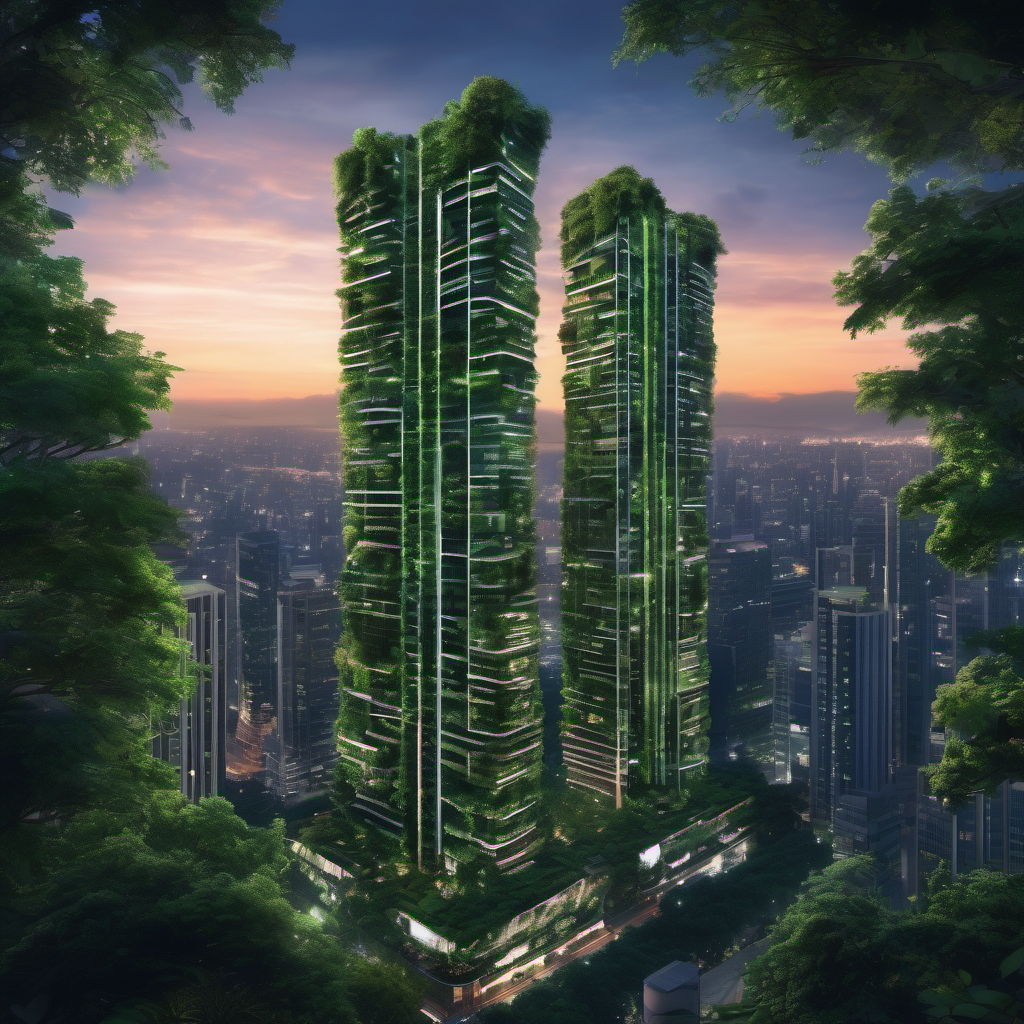In our journey towards a brighter and more sustainable future, the essence of design takes center stage. In this article “The Power of Sustainable Design in Sustainable Development” we can explore further insight regarding the topic.
It’s not just about creating aesthetically pleasing structures or products; it’s about crafting solutions that respect our planet and enhance the lives of people worldwide.
Join us as we explore the transformative power of sustainable design in driving sustainable development. Through creativity, ingenuity, and a deep commitment to environmental stewardship, we as humans are reshaping our world for the better, one thoughtful design at a time.
Sustainable design
In the quest for a more sustainable future, the role of design cannot be overstated.
From architecture to product development, sustainable design holds the key to minimizing environmental impact while maximizing efficiency and longevity.
In this article, we delve into the dynamic of sustainable design and its integral connection to the broader sustainable development goals.
By understanding the principles and practices of sustainable design, we can unlock innovative solutions that not only address current environmental challenges but also pave the way for a more resilient and harmonious relationship between humanity and the planet.
In the next paragraphs we will explore how sustainable design can mimic real world nature’s wonders, the flora and fauna and why is that important for us.
Unique organisms and their mysteries
Let’s get into the fascinating world of bioluminescent fungi, a topic often overlooked in discussions about bioluminescence and sustainability.
While many are familiar with bioluminescent organisms for example
- fireflies and
- certain deep-sea creatures,
few realize that certain species of fungi also possess this mesmerizing trait.
Found in diverse ecosystems around the globe, these luminous fungi emit a soft glow, often in shades of green or blue, creating enchanting displays in dark, wooded environments.
While the exact purpose of bioluminescence in fungi remains a subject of scientific inquiry, researchers believe it plays a role in attracting insects for spore dispersal or deterring herbivores.
Exploring the mysteries of bioluminescent fungi not only deepens our understanding of the natural world but also unveils the hidden wonders lurking beneath our forest floors.
Bioluminescent fungi innovative lighting solutions
Bioluminescent fungi offer a captivating example of nature’s ingenuity, presenting intriguing possibilities for sustainable development and design.
Firstly, their luminous properties could inspire innovative lighting solutions that reduce reliance on traditional energy sources. Imagine urban landscapes illuminated by bioluminescent fungi-based streetlights, offering not only aesthetic appeal but also energy efficiency and reduced carbon emissions.
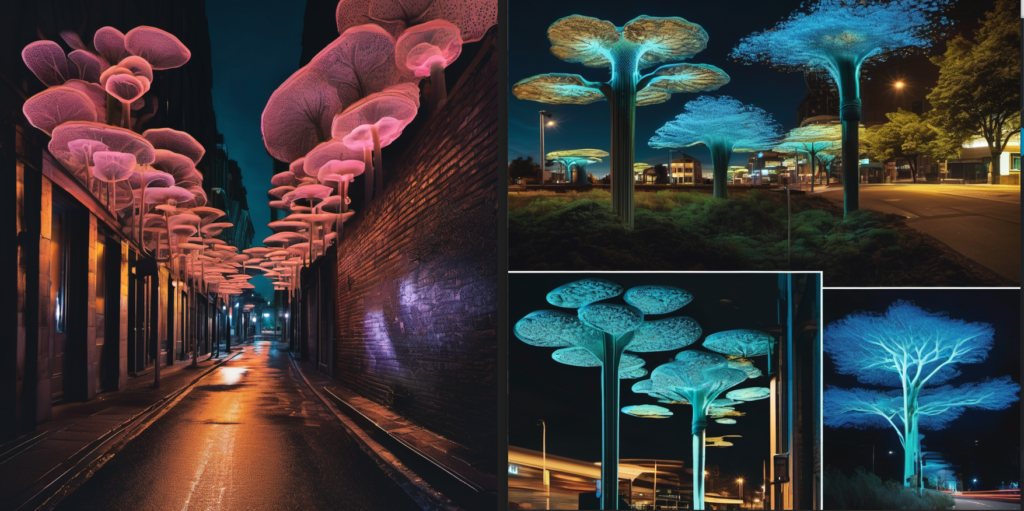
Furthermore, studying the mechanisms behind bioluminescence in fungi could unlock valuable insights for biotechnology and biomimicry.
By harnessing the biochemical pathways responsible for light emission, researchers may develop bioluminescent materials with applications in signage, safety markers, and low-energy displays, thus reducing the environmental footprint of conventional lighting technologies.
Additionally, the presence of bioluminescent fungi in natural ecosystems underscores the importance of preserving biodiversity and protecting habitats. Incorporating sustainable design practices that prioritize conservation and restoration help safeguard fungal populations and the delicate balance of ecosystems they inhabit.
In essence, bioluminescent fungi serve as a reminder of nature’s ability to inspire sustainable solutions. By integrating lessons from these remarkable organisms into our approach to design and development, we can cultivate more resilient, resource-efficient, and harmonious environments for generations to come.
Biomimetic wind turbines
One promising avenue for sustainable development technology inspired by nature is biomimicry, which involves emulating biological systems, processes, and strategies to solve human challenges.
One innovative and sustainable design concept that harnesses biomimicry is the development of “biomimetic wind turbines.“
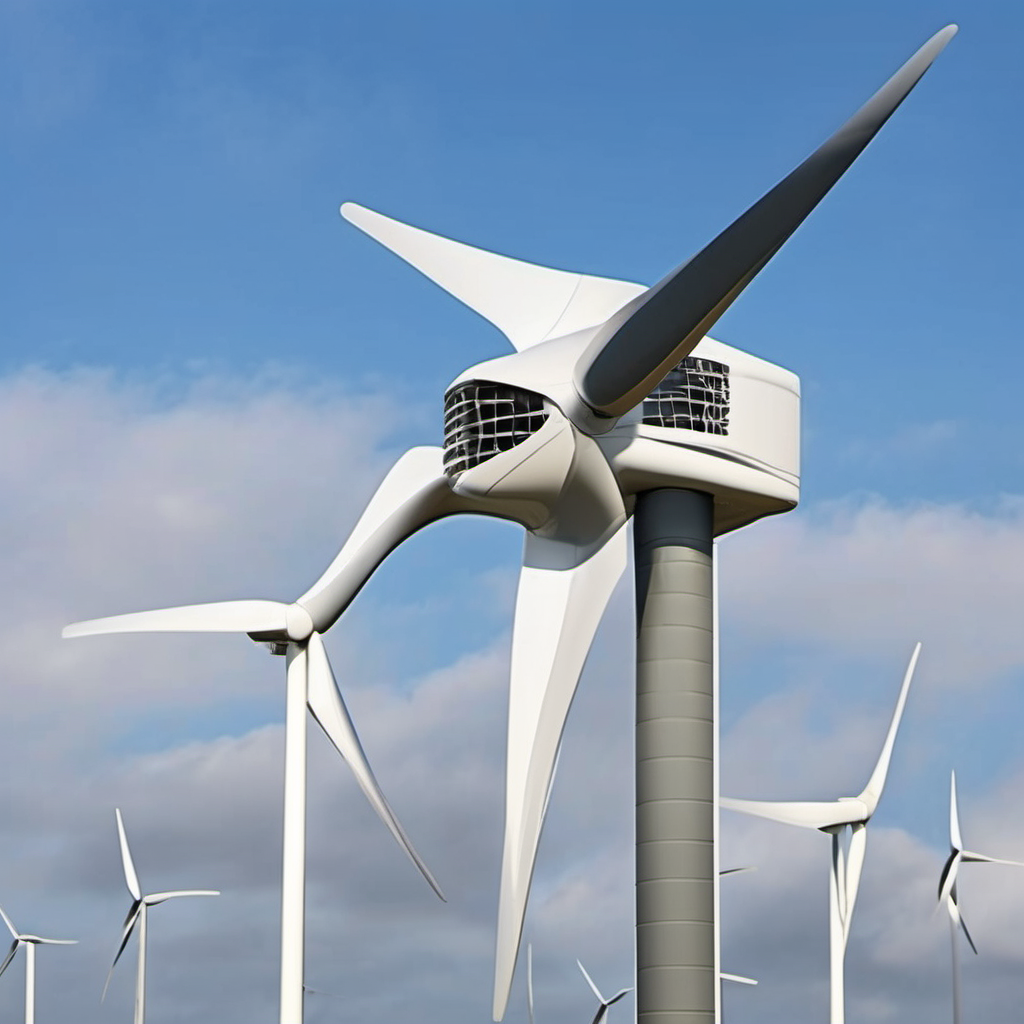
Energy optimization
Inspired by the efficient aerodynamics of bird wings and fish fins, biomimetic wind turbines are designed to optimize energy generation while minimizing environmental impact. These turbines incorporate features for example
- flexible,
- feather-like blades
that adjust their angle and shape in response to changing wind conditions, this way they can improving efficiency and reducing noise.
Biomaterials utilization
Moreover, biomimetic wind turbines utilize biomaterials inspired by natural structures for example spider silk or bamboo, offering lightweight yet durable construction options with minimal ecological footprint.
Sensor technologies to optimize performances
Additionally, these turbines integrate sensor technologies modeled after biological systems, allowing them to respond dynamically to environmental cues and optimize performance.
For example, sensors mimicking the sensory organs of birds can
- detect changes in wind direction and
- adjust turbine orientation accordingly, enhancing energy capture efficiency.
By drawing inspiration from the elegance and efficiency of nature, biomimetic wind turbines represent a sustainable development technology that not only
- reduces reliance on fossil fuels, but also
- minimizes ecological impact and maximizes renewable energy potential.
Through continued innovation in biomimetic design, we can unlock new possibilities for a cleaner, and greener energy future.
Verdant Veil Architecture
In the heart of bustling cityscapes, imagine a symphony of nature unfolding amidst the concrete jungle — an ethereal vision brought to life by “Verdant Veil Architecture.”
Picture towering skyscrapers adorned not with cold steel and glass, but with cascading curtains of lush greenery, gracefully draping down their facades like verdant waterfalls frozen in time.
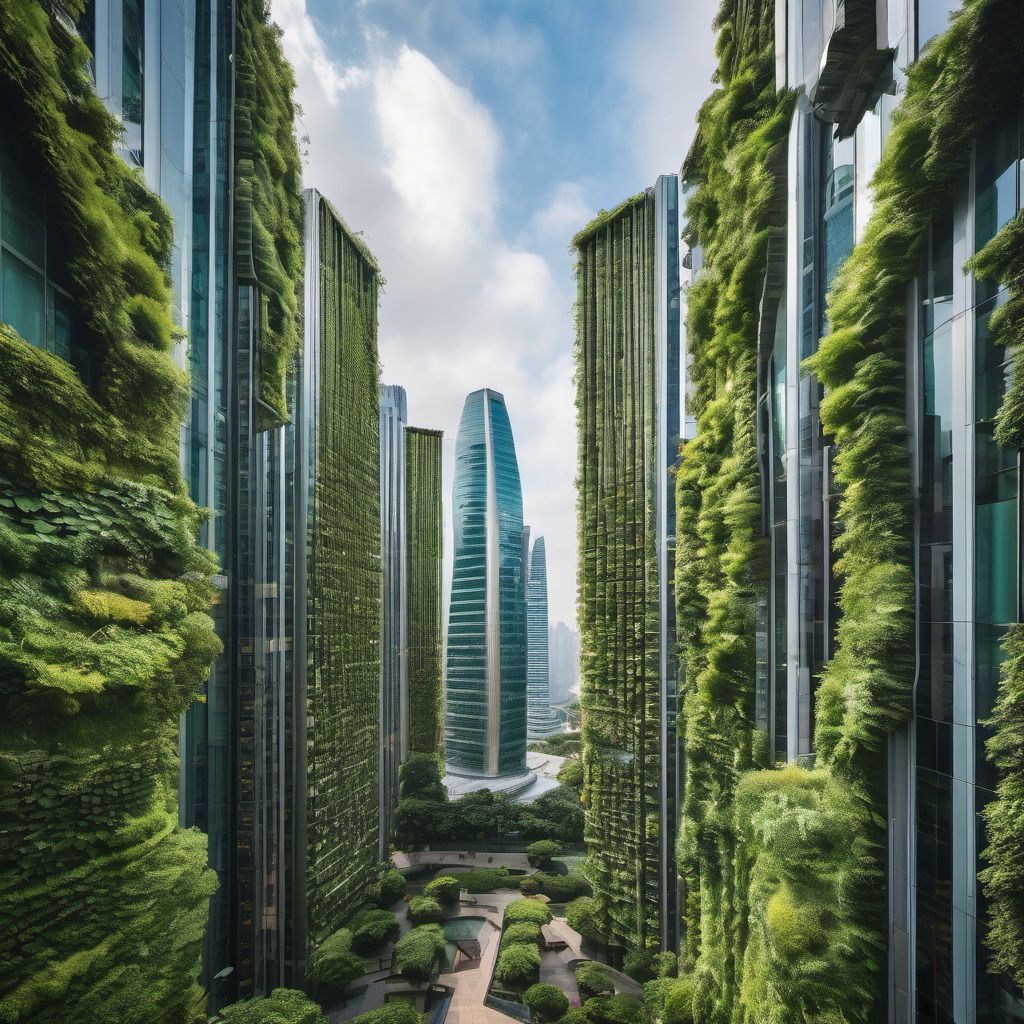
In this enchanting tapestry of green, each building becomes a living, breathing organism, pulsating with the rhythm of life.
Verdant veils
The verdant veils, meticulously curated to thrive in their urban habitat, dance in the gentle breeze, their emerald leaves catching the golden rays of the sun, casting a kaleidoscope of shadows that dance across the pavement below.
But the beauty of “Verdant Veil Architecture” transcends mere aesthetics — it is a testament to the harmonious coexistence of humanity and nature.
Thriving ecosystem
Amidst the verdant foliage, a thriving ecosystem emerges, bustling with
- the chirping of birds,
- the hum of bees, and the rustle of leaves
— a vibrant oasis in the midst of the urban sprawl.
Bioluminescent flora
As day transitions into night, the magic of “Verdant Veil Architecture” truly comes alive.
Soft moonlight filters through the canopy of leaves, casting a gentle glow upon the city streets below.
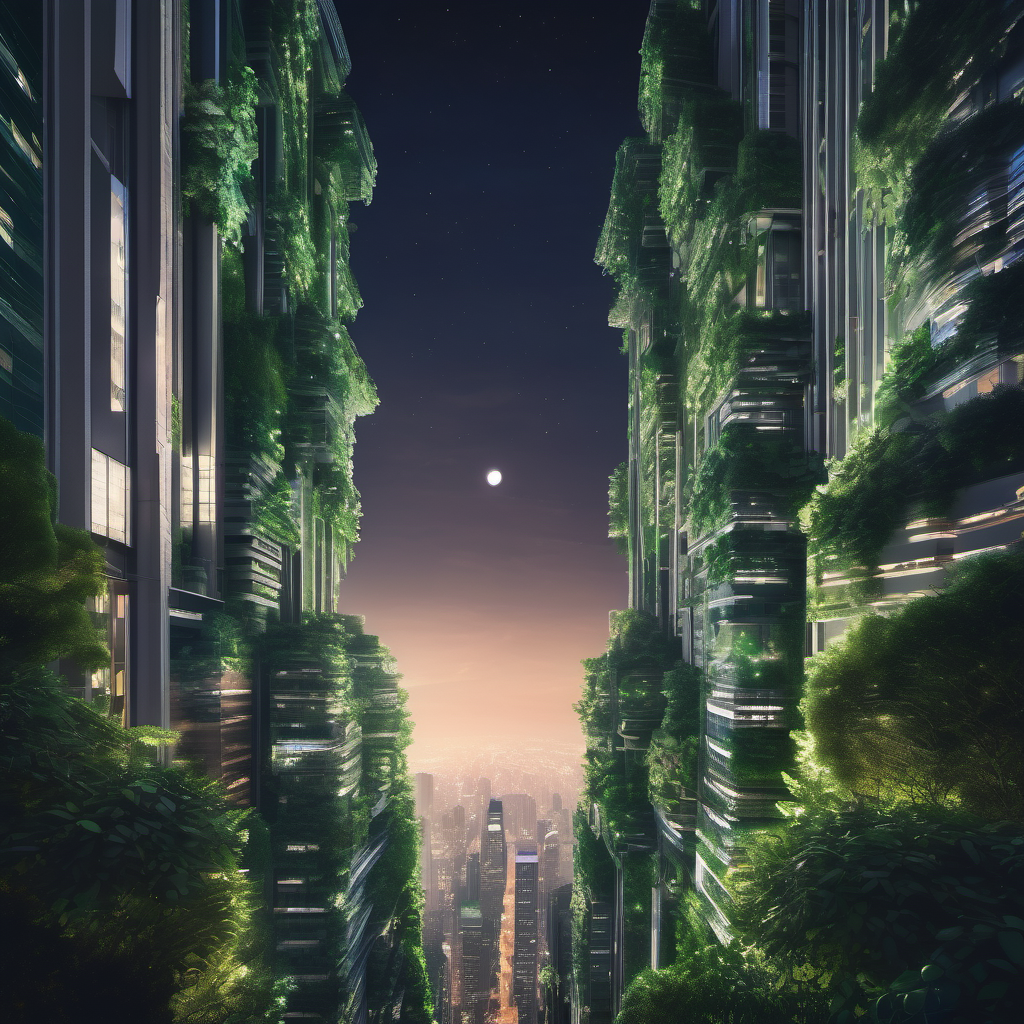
Bioluminescent flora, carefully interspersed within the verdant tapestry, add a touch of otherworldly beauty, their delicate radiance illuminating the darkness like a constellation of stars brought down to earth.
Sustainability and resilience
But beyond its sheer aesthetic allure, “Verdant Veil Architecture” embodies the essence of sustainability and resilience.
The living, breathing greenery serves as
- a natural air purifier,
filtering out pollutants and carbon dioxide, while also providing vital habitat for urban wildlife.
The veils act as
- a natural insulator,
regulating temperatures within the buildings and reducing energy consumption, while mitigating the urban heat island effect and alleviating stormwater runoff.
Harmony and the transformative power of design
In this vision of the future, humanity and nature are no longer at odds, but instead, dance together in perfect harmony — a guidance to the transformative power of design inspired by the beauty and wisdom of the natural world.
In the embrace of “Verdant Veil Architecture”, the city becomes not just a place of concrete and steel, but a living, breathing sanctuary — a true promise to the boundless creativity and ingenuity of the human spirit.
Top 5 sustainable design initiatives
The High Line, New York City, USA
This elevated park built on a former railway line not only preserves a historic structure but also incorporates sustainable landscaping, rainwater collection systems, and energy-efficient lighting, transforming an industrial relic into a vibrant urban green space.
Masdar City, Abu Dhabi, UAE
A planned eco-city striving for carbon neutrality, Masdar City integrates sustainable technologies such as solar power, wind turbines, and efficient waste management systems into its design, aiming to create a model for sustainable urban living in arid regions.
The Edge, Amsterdam, Netherlands
Renowned as the world’s greenest office building, The Edge utilizes advanced technologies like smart lighting, energy-efficient HVAC systems, and a rooftop solar array to achieve outstanding energy performance while prioritizing occupant comfort and well-being.
BioDome at the University of Bristol, UK
This pioneering research facility employs biomimicry principles to create a self-sustaining ecosystem within a geodesic dome. The BioDome explores sustainable food production methods, waste recycling, and renewable energy generation, offering valuable insights into ecological resilience.
Vertical Forests, Milan and Nanjing
Designed by Stefano Boeri Architetti, these pioneering skyscrapers integrate dense greenery into their facades, providing habitat for wildlife, improving air quality, and reducing energy consumption through natural insulation. The vertical forests represent a sustainable approach to high-density urban development, fostering biodiversity and human well-being in densely populated cities.
IoT, Sustainable Design and Smart Cities
The integration of Internet of Things (IoT) technology in smart cities presents a transformative opportunity for advancing sustainable design practices.
IoT solutions in smart cities
By leveraging IoT sensors, data analytics, and connectivity solutions, cities can optimize energy usage, improve intelligent transportation systems, and streamline waste management processes.
- Smart grids and buildings reduce energy consumption, while intelligent transportation systems reduce traffic congestion and emissions.
- IoT-enabled waste management streamlines collection and promotes recycling.
IoT effects on smart cities
Moreover, IoT enables cities to
- achieve greater efficiency,
- reduce environmental impact, and
- enhance the overall quality of urban life.
As we continue to embrace IoT innovations in urban planning and development, we move closer to creating more sustainable, resilient, and livable cities for generations to come.
In smart cities, IoT technology offers opportunities for sustainable design and facilitates efficient resource usage and contributes to a more sustainable urban environment.
Conclusion
In conclusion, the power of sustainable design in sustainable development cannot be overstated.
Through innovative approaches that prioritize environmental stewardship, social equity, and economic prosperity, sustainable design holds the key to addressing the complex challenges facing our planet.
From energy-efficient buildings and green infrastructure to biomimetic technologies and circular economy principles, sustainable design offers solutions that not only mitigate environmental impact but also enhance quality of life and promote long-term resilience.
By embracing the principles of sustainable design and integrating them into our policies, practices, and everyday lives, we can create a more equitable, prosperous, and harmonious world for current and future generations.
Together, let us harness the transformative potential of sustainable design to build a brighter, more sustainable future for all.
The article written by Reka A. Szanto. Pictures and designs are her own works (Copyrights law & Greenfrastructures.com).
